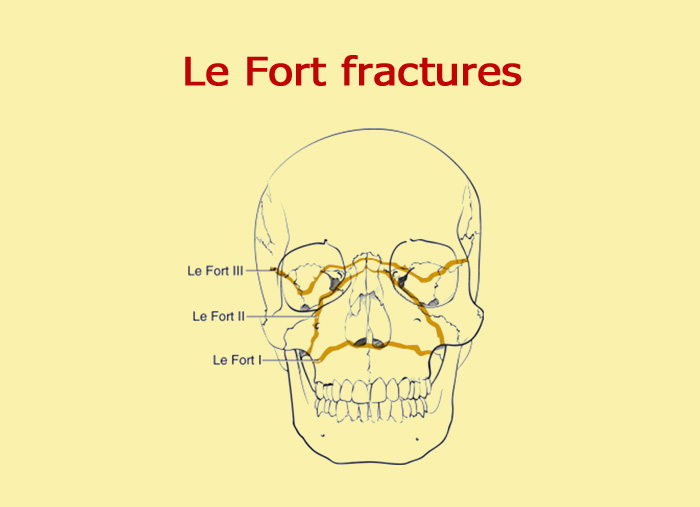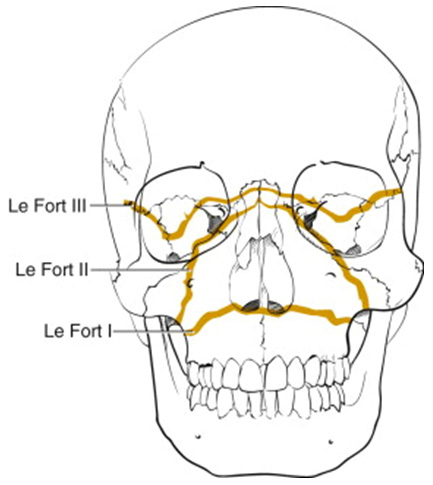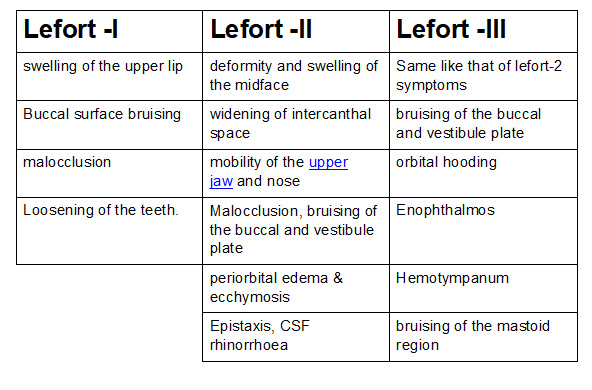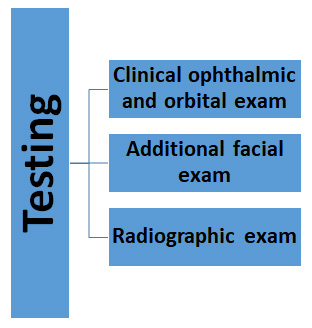- NEED HELP? CALL US NOW
- +919995411505
- [email protected]
Le Fort fractures

Fractures of the midface, which collectively involve separation of all or a portion of the midface from the skull base. In order to be separated from the skull base, the pterygoid plates of the sphenoid bone need to be involved as these connect the midface to the sphenoid bone dorsally.
The Le Fort classification system attempts to distinguish according to the plane of injury


The Le Fort classification system attempts to distinguish according to the plane of injury

Classification
The commonly used classification is as follows:- Le Fort type I (floating palate (horizontal))
- horizontal maxillary fracture, separating the teeth from the upper face
- fracture line passes through the alveolar ridge, lateral nose and inferior wall of the maxillary sinus
- also known as a Guerin fracture
- Le Fort type II (floating maxilla (pyramidal))
- pyramidal fracture, with the teeth at the pyramid base, and nasofrontal suture at its apex
- fracture arch passes through the posterior alveolar ridge, lateral walls of maxillary sinuses, inferior orbital rim and nasal bones
- uppermost fracture line can pass through the nasofrontal junction or the frontal process of the maxilla
- Le Fort type III (floating face (transverse))
- craniofacial disjunction
- transverse fracture line passes through nasofrontal suture , maxillo-frontal suture , orbital wall , and zygomatic arch / zygomaticofrontal suture
- because of the involvement of the zygomatic arch, there is a risk of the temporalis muscle impingement
- unsurprisingly type III fractures have the highest rate of CSF leak

How do you diagnose?
A computerized tomography (CT) scan of the facial bones is often required to fully assess the extent of the injury.

Clinical ophthalmic and orbital exam:
- Visual acuity for signs of ocular injury such as traumatic optic neuropathy, ruptured globe, retinal edema, or retinal tear
- Extraocular motility exam and the presence of pain or diplopia with movement
- Pupil exam for signs of an afferent pupillary defect, sphincter tear, ruptured globe, or traumatic mydriasis
- Facial sensation/infraorbital nerve evaluation
- Globe position with exophthalmometry and vertical position assessment
- Canthal assessment to evaluate for telecanthus
- Soft-tissue examination for lacerations and eyelid malposition
- Palpation of orbital rim for step deformities
- Airway compromise assessment
- Facial nerve function
- Soft tissue assessment for Battle's sign (bruising over mastoid)
- Midfacial retrusion assessment
- Intraoral exam to assess bite for dental occlusion abnormality (often anterior open bite) and intraoral bruising
- Intranasal exam for bleeding or cerebral spinal fluid (CSF) rhinorrhoea
- Midface segment mobility exam: Stabilize forehead with one hand, grasp anterior alveolar arch/upper teeth with the other, and pull forward; can be immobile with severe impaction.
- Although plain films such as PA and Water's views can demonstrate sinus bleeding and fracture lines, modern assessment requires imaging with CT scan.
Differential Diagnosis
- Zygomatic maxillary complex fractures
- NOE fractures
- Internal orbital fractures (floor and/or medial wall fractures)
- Optic canal fractures
- Pertinent patient management in terms of treatment and follow-up

MCQS
Q. Lefort III fracture is same as
A) Craniofacial dysjunctionB) Guerin fracture
C) Pyramidal fracture
D) None of the above
Answer: A
Related posts
April 10, 2025
April 9, 2025
April 4, 2025




